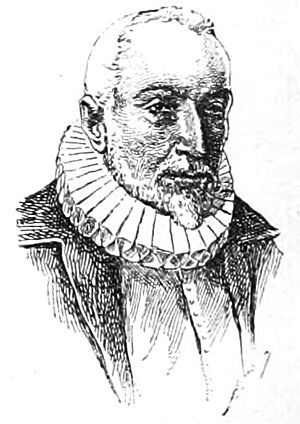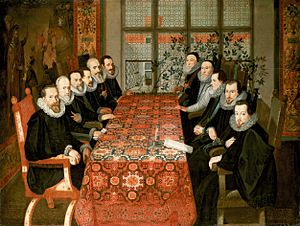Jean Richardot facts for kids
Quick facts for kids
Jean Richardot
|
|
|---|---|
 |
|
| President of the Privy Council of the Habsburg Netherlands | |
| In office 1597–1609 |
|
| Monarch | Archdukes Albert and Isabella |
| Succeeded by | Engelbert Maes |
| Personal details | |
| Born |
Jean Grusset
1540 Champlitte, Franche-Comté |
| Died | 3 September 1609 Arras |
| Resting place | Church of St Gudula, Brussels |
| Spouse | Anne Courcol de Baillencourt |
| Relations | François Richardot (maternal uncle) |
| Parents | Guillaume Grusset and Marguerite Richardot |
| Education | civil law |
| Alma mater | Leuven University |
Jean Richardot (born 1540, died 1609) was an important statesman and diplomat. He came from a region called Franche-Comté. He held high positions during the Dutch Revolt. He helped bring back the rule of the Habsburg family in the Southern Netherlands.
Contents
Early Life and Education
Jean Richardot was born in Champlitte in 1540. His birth name was Jean Grusset. His mother was Marguerite Richardot and his father was Guillaume Grusset. Jean's uncle, François Richardot, was a very important person. He was a close helper of Margaret of Parma, who ruled the Habsburg Netherlands. François Richardot also became the bishop of Arras.
Jean's uncle helped him get a good education. Jean studied law at Leuven University. He also studied in Rome and Padua. He earned his law degree from the University of Bologna. Later, Jean Grusset decided to use his uncle's last name, Richardot.
Starting His Career
In 1568, King Philip II made Richardot a councillor. This was in the Great Council of Mechelen. Seven years later, he joined the Privy Council of the Habsburg Netherlands. This council gave advice to the Governor-General. At that time, Don Luis de Requesens y Zúñiga was the Governor-General.
After Requesens died, Richardot supported the Dutch Revolt. He even joined the rebels' Privy Council. He was sent to Arras to try and convince the local leaders not to join the Union of Arras.
Working for Alexander Farnese
Soon, Richardot changed his mind. He decided to support the new Governor-General, Alexander Farnese. Richardot even wrote a funny story making fun of William the Silent, a leader of the Dutch Revolt. Farnese quickly saw how talented Richardot was. In 1580, he confirmed Richardot's place on the Privy Council. In 1581, Richardot became the president of the Council of Artois.
One of Richardot's first big successes was convincing the leaders of Artois to let Spanish soldiers return. King Philip II then made Richardot a knight. In 1583, he joined the Council of State. This was the highest council that advised on important state matters.
Helping to Make Peace
Farnese used Richardot to help make peace with many towns. These towns were in Flanders and Brabant. Some of these towns included Ypres, Bruges, Ghent, Brussels, and Antwerp. Richardot also led a group that met with Queen Elizabeth I's helpers in 1587. They pretended to try and end the war between England and Spain.
Richardot traveled to Madrid twice to meet King Philip II. In 1583-1584, he asked for more soldiers and money for the war. In 1589, he had to explain why Farnese failed to invade England with the Spanish Armada.
After Farnese died in 1592, Richardot's career slowed down. Some leaders even tried to remove him from the Council of State.
Leading the Privy Council
Richardot's career got back on track in 1596. This was when Archduke Albert became the new Governor-General. In 1597, Albert made Richardot the Chief-President of the Privy Council. From then on, Richardot was the most important person working for the Archdukes Albert and Isabella.
Richardot believed in making peace in the Netherlands. Some people who wanted to continue the war thought he was not loyal to Spain. But Richardot's ideas for peace slowly won out.

Richardot was key in many important talks. He often worked with Lodewijk Verreycken.
- In 1598, they helped create the Peace of Vervins. This was a peace treaty between King Philip II and Henry IV of France.
- In 1600, Richardot tried to end the war between Elizabeth I and Philip III. But the talks failed.
- When James I of England became king, there was a new chance for peace. Richardot, Verreycken, and Charles of Arenberg worked on the Treaty of London in 1604.
- In 1608, Richardot and Ambrogio Spinola led talks with the Dutch Republic. They hoped for a lasting peace. But they could not agree on religion and trade.
- Finally, with help from France and England, they signed the Twelve Years' Truce in 1609. This was a ceasefire, not a full peace treaty.
Later Life and Family
Soon after the Truce, a problem came up. This was about who would rule the Duchies of Jülich, Cleves, and Berg. King Henry IV of France and Archduke Albert disagreed strongly. Also, the Prince of Condé ran away to Brussels with his wife. He wanted to keep her away from the French king.
Richardot traveled to France in August 1609. He wanted to tell Henry IV that Albert would stay neutral. Henry IV met Richardot outside. He made the almost 70-year-old minister stand in the sun for over an hour without a hat. Richardot became very ill from the heat. He died on his way home on September 3, 1609. He was buried in Brussels.
In 1568, Jean Richardot married Anne Courcol de Baillencourt. She came from a noble family. They had twelve children. Some of their notable children were:
- Françoise, who married Conrad III Schetz. He became the first baron of Hoboken. He was also the first ambassador to England.
- Jean Richardot the Younger, who became the bishop of Arras and later the archbishop of Cambrai.
- François, a cavalry officer who died in the Battle of Nieuwpoort.
- Pierre, who became the abbot of Echternach.
- Guillaume Richardot, who was educated by Justus Lipsius. He became the count of Galmaarden.
- Antoine Richardot, also educated by Justus Lipsius. He was a cavalry captain and died from wounds after a battle.
Images for kids


